Prospects for Agricultural Sustainable Intensification: A Review of Research
Abstract
1. Introduction
2. The Conceptual Connotation of Agricultural Sustainable Intensification
2.1. The Development of Agricultural Sustainable Intensification
2.2. The Connotation of Agricultural Sustainable Intensification
2.3. The Relationship and Difference between Agricultural Sustainable Intensification and Ecological Intensification
3. Research Progress in the Measurement of Agricultural Sustainable Intensification
3.1. Measurement Index System for Agricultural Sustainable Intensification
3.2. Measuring Method of Agricultural Sustainable Intensification
3.3. Cases of Agricultural Sustainable Intensification Measurement
4. Research Progress in Research on Influencing Factors of Agricultural Sustainable Intensification
4.1. Changes in Socio-Economic Factors are the Main Factors Restricting Agricultural Sustainable Intensification
4.2. Population Pressure is a Potential Driver of Agricultural Sustainable Intensification
4.3. Agricultural Sustainable Intensification is the Combined Result of Multiple Factors
5. Research Progress on the Realization Path of Agricultural Sustainable Intensification
5.1. Main Characterization of Agricultural Sustainable Intensification
5.1.1. Internal Optimization Path for Agricultural Systems
5.1.2. External Input Path for Agricultural System
5.2. The Practice Path for Agricultural Sustainable Intensification
6. Conclusions and Prospects for Agricultural Sustainable Intensification
6.1. Clarification of the Connotation of Agricultural Sustainable Intensification
6.2. Study on Agricultural Sustainable Intensification Models in Different Regions
6.3. Study on the Influencing Mechanism of Agricultural Sustainable Intensification
6.4. Research on the Effect Evaluation of Agricultural Sustainable Intensification
6.5. Study on Farmers’ Incentive Mechanism of Agricultural Sustainable Intensification
6.6. Institutional Design Research on Agricultural Sustainable Intensification
Author Contributions
Funding
Acknowledgments
Conflicts of Interest
Appendix A
| Study Area | Primary Indicator | Secondary Indicators | Total Indicators2 | Source |
|---|---|---|---|---|
| Sustainable Intensification Indicators for Smallholder Farming Systems in Africa | productivity | yield, input efficiency, water efficiency, animal health | 57 | [68] |
| economic sustainability | agricultural income, crop value | |||
| environmental sustainability | biodiversity, carbon sequestration, erosion, nutrient dynamics, soil biological activity, soil quality | |||
| social sustainability | information acquisition | |||
| human well-being | food and nutrition security, risk | |||
| Ecological Intensification Indicators for Coconut Production in Brazilian Farms | landscape ecology | natural habitat status, production area management and livestock/restricted activities, environmental quality, landscape and production diversity, risks | 62 | [69] |
| environmental quality | atmospheric emissions, water quality, soil quality | |||
| social and cultural values | education, public services, consumer standards, sports and leisure, cultural/natural heritage, occupational health, qualified employment | |||
| economic values | net income, income source diversity, income distribution, debt, land value, housing quality | |||
| management | manager profile and dedication, manager qualification and professional proficiency, chemical input management | |||
| Sustainable Intensification Indicators for UK’s Agricultural System | resource systems | productivity, land area, farm size, landscape features, ruins | 110 | [70] |
| resource units | soil characteristics, biodiversity, livestock, events, crop diversity, water depth | |||
| governance | agricultural subsidies, land leases, animal welfare, farmers’ fair negotiation ability | |||
| resource users | farmer age, succession plan, social network, housing, employment, number of native speakers | |||
| interactions | degree of mechanization, landscape characteristics, agricultural technology, livestock rearing, farming quantity, crop characteristics, farm size | |||
| outcomes | yield, income, greenhouse gases, agricultural pollution, resource use efficiency, landscape characteristics, farm size, farmer welfare | |||
| environment | credit, product prices, agricultural competitiveness, frequency of extreme events, consumer characteristics, amount of funds |
| Authors3 | Journal | Scale | Influencing factors and Nature of Indicators4 | Number of Indicators Used | Publication Year |
|---|---|---|---|---|---|
| Alex Smith | Global Food Security | multi-scale | yield(+), input efficiency(+), water efficiency(+), animal health(+), agricultural income(+), crop value(+), food and nutrition security(+), risk(–), biodiversity(+), carbon sequestration(+), erosion(–), nutrient dynamics(+), soil biological activity(+), soil quality(+), information access(–), gender equity(±). | primary indicator: secondary indicators: 17 three-level indicator: 57 | 2017 |
| B. Vanlauwe | Environmental Sustainability | farmer | soil fertility(+), population pressure(±), production gap(±), livelihood strategy(±), market access(+). | no specific number of indicators | 2014 |
| Daniel Kyalo Willy | Land Use Policy | farm | maize yield(+), mechanized land preparation(–), quantity of manure used(+), farm has cashcrop(–), population density(±), access to information(+), farmers’ behavior(±), climatic conditions(~), total organic carbon(±). | 35 | 2019 |
| David L. Ortega | World Development | farmer | legume yield(+), distance to market(–), labor requirements(–), maize yield(+), soil fertility(+), population density(+), market access(+), imperfect infrastructure(+), farmers’ preferences(±). | a total of 40 choice sets | 2016 |
| Eric Rahn | Agriculture, Ecosystems and Environment | farmer | gender(~), age(–), education(+), wealth(+), coffee importance(+), family size and age(±), member of cooperative(+), extension service(+), access to credit(+), intercropping(±), altitude(+), slope(–), dist. Between homestead and plot(–). | 13 | 2018 |
| Fred Zaal | World Development | village | density(+), travel time to market(–), price coffee/maize(+), drought in Kitui(+), population density(+), crop price fluctuations(–). | 6 | 2002 |
| Geraldo Stachetti Rodrigues | Agricultural Systems | farm | environmental quality(+), landscape and production diversity(+), risks(–), water quality(+), soil quality(+), education(+), public services(+), consumer standards, net income(+), income source diversity(–), chemical input management(–). | a total of 62 indicators | 2018 |
| Jonathan Vayssières | Agricultural Systems | farm | forage productivity(+), milk productivity(+), feed conversion efficiency(+), N dynamics(+), energy consumptions(–), the total labor requirement(–), farm type(±), gross margin(+), crop-livestock integration(+), food demand growth(+), environmental stress(+), farm self-sufficiency(–). | 12 | 2011 |
| Jasmin Schiefer | International Soil and Water Conservation Research | plot | organic C content(+), clayþsilt(~), pH(±), cation exchange capacity(+), population pressure(+), food demand(+), soil organic matter(+), slope(–), soil depth(~). | six intrinsic land and soil characteristics | 2015 |
| José Cortez-Arriola | Agricultural Systems | farm | biophysical environment(±), socio-economics(±), crops(+), crop products(+), animals and herd composition(±), animal products(+), manure types and degradation(±), external sources of mineral nutrients(±), physical assets (+). | 30 | 2016 |
| Menale Kassie | Land Use Policy | plot | soil fertility(+), soil depth(~), plot slope(–), distance of the plot from residence(–), tenure(+), plot size(~), pests disease(–), farm age(–), education level(+), salary(~), farm size(±), walking distance to main markets(–), agricultural extension services(+), credit-access(+), market access(+),individuals’ social networks(+). | six dependent variable indicators | 2015 |
| Mastewal Yami | Journal of Rural Studies | country | pest management(+), post-harvest technologies(+), agrochemicals(–), improved varieties(+), farm technologies(+), agriculture extension systems(+), public private partnerships(+), local innovations(+), crop insurance systems(+), income(+), agriculture finance(+). | 16 | 2017 |
| N. Mahon | Land Use Policy | multi-scale | yield(+), farm size(±), area of irrigated land(~), soil organic(+), farmland bird numbers(+), diversity of crops(+), livestock mortality rates(–), animal welfare(+), age of farmers(–), educational level of famers(+), age of farm infrastructure(–), farmer attitudes towards technology(~), crop rotations(+), quantity of fertilizers used per hectare(–), extent of farm mechanization(+), farmer income(+), water use efficiency(+), cost of production(–), output prices(–), agriculture competitive(+). | a total of 110 SI indicators | 2018 |
| O. Cortner | Land Use Policy | farm | culture(~), market access(+), product prices(+), ranch facilities(+), credit access(+), lack of marketing options(–), biotic factors(~), abiotic factors(~), policy risks(–). | four first-level indicators | 2019 |
| S. Wagura Ndiritu | Food Policy | plot level | plot size(+), plot distance to residence(–), land fertility(+), plot slope(–), plot depth(~), farmer age(–), household size(+), farm size(–), extension services(+), distance to the nearest main market(+), per capita expenditure(+), livestock ownership(±), social capital/network(±). | seven dependent variables indicators | 2014 |
| Sieglinde S. Snapp | Agricultural Systems | farm | rainfall(–), weather conditions(~), soil characterization(~), elevation(–), farm size(+), income sources(~), labor availability(+), livestock and other assets(+), spacing(±), seeding rates(±) combinations of crops(±), soil amendments(+), net income(+), food security(+), gender equity(±), crop yield(+). | 15 SI indicators | 2018 |
References
- Food and Agriculture Organization of the United Nations (FAO). The Ethics of Sustainable Agricultural Intensification; Ethics Series; Food and Agriculture Organization of the United Nations: Rome, Italy, 2004; pp. 3–5. [Google Scholar]
- Senker, P. Foresight: The future of food and farming, final project report. Prometheus 2011, 29, 309–313. [Google Scholar] [CrossRef]
- Suhardiman, D.; Giordano, M.; Leebouapao, L. Farmers’ strategies as building block for rethinking sustainable intensification. Agric. Hum. Values 2016, 33, 563–574. [Google Scholar] [CrossRef]
- Godfray, H.C.J. The debate over sustainable intensification. Food Secur. 2015, 7, 199–208. [Google Scholar] [CrossRef]
- Davis, C. An Adventure in Applied Science: A History of the International Rice Research Institute by Robert F. Chandler. J. Hist. Sci. 1983, 74, 595–596. [Google Scholar]
- Gordon, C.; Katy, W. Food War: What Do We Take to Feed the World; M. Publishing House of Electronics Industry: Beijin, China, 2014; pp. 46–48. [Google Scholar]
- Stakman, E.; Bradfield, R.; Mangelsdorf, P. Campaigns against Hunger; Harvard University Press: Cambridge, MA, USA, 1967. [Google Scholar]
- Hazell, P.B.R. An Assessment of the Impact of Agricultural research in South Asia Since the Green Revolution. Science Council Secretariat: Rome, Italy, 2008. [Google Scholar]
- Tilman, D.; Cassman, K.G.; Matson, P.A. Agricultural sustainability and intensive production practices. Nature 2002, 418, 671–677. [Google Scholar] [CrossRef] [PubMed]
- Wezel, A.; Soboksa, G.; Mcclelland, S. The blurred boundaries of ecological, sustainable, and agroecological intensification: A review. Agron. Sustain. Dev. 2015, 35, 1283–1295. [Google Scholar] [CrossRef]
- Burney, J.A.; Davis, S.J.; Lobell, D.B. Greenhouse gas mitigation by agricultural intensification. Proc. Natl. Acad. Sci. USA 2010, 107, 12052–12057. [Google Scholar] [CrossRef] [PubMed]
- Tilman, D.; Balzer, C.; Hill, J. Global food demand and the sustainable intensification of agriculture. Proc. Natl. Acad. Sci. USA 2011, 108, 20260–20264. [Google Scholar] [CrossRef]
- Long, Y.Q.; Wu, W.B.; Yu, Q.Y. Review on the Research Progress of Intensive Use of Cultivated Land. Nat. Resour. 2018, 33, 337–350. (In Chinese) [Google Scholar]
- Zuo, L.; Zhang, Z.; Carlson, K.M. Progress towards sustainable intensification in China challenged by land–use change. Nat. Sustain. 2018, 1, 304–313. [Google Scholar] [CrossRef]
- Yu, Z.N.; Zhang, X.B.; Wu, C.F. Review on the Progress of Land Science Related Research in the Journals of Nature and Science from 2000 to 2016. China Land Sci. 2017, 31, 89–97. (In Chinese) [Google Scholar]
- Zhu, H.Y.; Sun, M.H. Review and future work focus of land use intensification research. Acta Geogr. Sin. 2014, 69, 1346–1357. (In Chinese) [Google Scholar]
- Zhang, X.H.; Yang, D.G.; Wang, C.Y. Relationship between Intensive Use of Cultivated Land and Environmental Pressure Based on Land Scale: A Case Study of 780 Lands in Tarim River Basin. Chin. Eco-Agric. 2012, 20, 635–642. (In Chinese) [Google Scholar] [CrossRef]
- Song, M. Analysis and Evaluation of Environmental Cost in the Utilization of Cultivated Land Resources: A Case Study of Wuhan City, Hubei Province. Chin. Popul. Resour. Environ. 2013, 23, 76–83. (In Chinese) [Google Scholar]
- Liu, Q.; Chen, L.G. Comprehensive Evaluation and Spatial Division of Sustainable Land Use in Changsha, Zhuzhou and Xiangtan Areas. Trans. Chin. Soc. Agric. Eng. 2013, 29, 245–253. (In Chinese) [Google Scholar]
- Liu, F.; Zhang, H.Q. Evaluation of Sustainable Land Use in Main Producing Areas of Agricultural Products in China. J. Nat. Resour. 2012, 27, 1138–1153. (In Chinese) [Google Scholar]
- Zhao, G.S.; Wang, Y.C.; Tang, X.W. Sustainability Evaluation of Intensive Farmland Ecosystem Based on Emergy Ecological Footprint Method. Trans. Chin. Soc. Agric. Eng. 2014, 30, 159–167. (In Chinese) [Google Scholar]
- Xie, H.L.; He, Y.F.; Zou, J.L. Spatio-temporal difference analysis of cultivated land use intensity based on emergy in the Poyang Lake Eco-economic Zone of China. J. Geogr. Sci. 2016, 26, 1412–1430. [Google Scholar] [CrossRef]
- Cao, Z.L. Construction and Evaluation of Regional Agricultural Sustainable Development Index System—Taking Hengyang City as an Example. Econ. Geogr. 2012, 32, 113–116. (In Chinese) [Google Scholar]
- Yin, G.X. Environmental risk early warning research on intensive agricultural land use based on material flow analysis. D China Agric. Univ. 2016, 33–34. (In Chinese) [Google Scholar]
- Niu, S.D.; Lü, X.; Shi, Y.Y. Temporal and spatial patterns of sustainable intensification of agricultural land use in Shandong Province. Chin. J. Appl. Ecol. 2018, 29, 607–616. (In Chinese) [Google Scholar]
- Kassie, M.; Teklewold, H.; Jaleta, M. Understanding the adoption of a portfolio of sustainable intensification practices in eastern and southern Africa. Land Use Policy 2015, 42, 400–411. [Google Scholar] [CrossRef]
- Ndiritu, S.W.; Kassie, M.; Shiferaw, B. Are there systematic gender differences in the adoption of sustainable agricultural intensification practices? Evidence from Kenya. Food Policy 2014, 49, 117–127. [Google Scholar] [CrossRef]
- David, L.O.; Kurt, B.W.; Robert, B.R. Sustainable Intensification and Farmer Preferences for Crop System Attributes: Evidence from Malawi’s Central and Southern Regions. World Dev. 2016, 87, 139–151. [Google Scholar]
- Vanlauwe, B.; Coyne, D.; Gockowski, J. Sustainable intensification and the African smallholder farmer. Curr. Opin. Environ. Sustain. 2014, 8, 15–22. [Google Scholar] [CrossRef]
- Tittonell, P.; Giller, K.E. When yield gaps are poverty traps: The paradigm of ecological intensification in African smallholder agriculture. Field Crops Res. 2013, 143, 76–90. [Google Scholar] [CrossRef]
- Falconnier, G.N.; Descheemaeker, K.; Traore, B. Agricultural intensification and policy interventions: Exploring plausible futures for smallholder farmers in Southern Mali. Land Use Policy 2018, 623–634. [Google Scholar] [CrossRef]
- Franke, A.C.; Vand, B.G.J.; Giller, K.E. Which farmers benefit most from sustainable intensification? An ex-ante impact assessment of expanding grain legume production in Malawi. Eur. J. Agron. 2014, 58, 28–38. [Google Scholar] [CrossRef]
- Duriaux, C.; Baudron, J.Y. Retaining forests within agricultural landscapes as a pathway to sustainable intensification: Evidence from Southern Ethiopia. Agric. Ecosyst. Environ. 2018, 263, 41–52. [Google Scholar] [CrossRef]
- Cortner, O.; Garrett, R.D.; Valentim, J.F. Perceptions of integrated crop-livestock systems for sustainable intensifcation in the Brazilian Amazon. Land Use Policy 2019, 82, 841–853. [Google Scholar] [CrossRef]
- Rosa, M.F.; Bonham, C.A.; Dempewolf, J. An integrated approach to monitoring ecosystem services and agriculture: Implications for sustainable agricultural intensification in Rwanda. Environ. Monit. Assess. 2017, 189, 15. [Google Scholar] [CrossRef]
- Vorlaufer, T.; Falk, T.; Dufhues, T. Payments for ecosystem services and agricultural intensification: Evidence from a choice experiment on deforestation in Zambia. Ecol. Econ. 2017, 141, 95–105. [Google Scholar] [CrossRef]
- Pretty, J.N. The Sustainable Intensification of Agriculture. In Natural Resources Forum; Blackwell Publishing Ltd.: Oxford, UK, 1997. [Google Scholar]
- Petersen, B.; Snapp, S. What is sustainable intensification? Views from experts. Land Use Policy 2015, 46, 1–10. [Google Scholar] [CrossRef]
- Baulcombe, D.; Crute, I.; Davies, B. Green N: Reaping the Benefits: Science and the Sustainable Intensification of Global Agriculture; Royal Society: London, UK, 2009. [Google Scholar]
- Food and Agriculture Organization (FAO). Save and Grow. A Policymaker’s Guide to the Sustainable Intensification of Smallholder Crop Production; FAO: Rome, Italy, 2011; 102p. [Google Scholar]
- Griffon, M. Qu’est-ce que l’agriculture écologiquement intensive? In Collection: Matière à débattre et décider; Editions Quae: Versailles, France, 2013; p. 224. [Google Scholar]
- Council, N.R. Toward Sustainable Agricultural Systems in the 21st Century; National Academies Press: Washington, DC, USA, 2010. [Google Scholar]
- Beddington, J.R.; Asaduzzaman, M.; Clark, M. Achieving Food Security in the Face of Climate Change: Final Report from the Commission on Sustainable Agriculture and Climate Change; CGIAR Research Program on Climate Change, Agriculture and Food Security: Frederiksberg, Denmark, 2011. [Google Scholar]
- Cassman, K.G. Ecological intensification of cereal production systems: Yield potential, soil quality, and precision agriculture. Proc. Natl. Acad. Sci. USA 1999, 96, 5952–5959. [Google Scholar] [CrossRef] [PubMed]
- Centre de Coopération Internationale en Recherche Agronomique Pour le Développement (CIRAD). CIRAD Strateg Vision; CIRAD: Montpellier, France, 2008. [Google Scholar]
- Food and Agriculture Organization (FAO). Organic Agriculture: Glossary on Organic Agriculture; FAO: Rome, Italy, 2009; pp. 1–173. [Google Scholar]
- Foley, J.A.; Ramankutty, N.; Brauman, K.A. Solutions for a cultivated planet. Nature 2011, 478, 337–342. [Google Scholar] [CrossRef] [PubMed]
- Snapp, S.S.; Blackie, M.J.; Gilbert, R.A. Biodiversity can support a greener revolution in Africa. Proc. Natl. Acad. Sci. USA 2010, 107, 20840–20845. [Google Scholar] [CrossRef] [PubMed]
- Gibon, A.; Sibbald, A.R.; Flamant, J.C. Livestock farming systems research in Europe and its potential contribution for managing towards sustainability in livestock farming. Lives. Prod. Sci. 1999, 61, 121–137. [Google Scholar] [CrossRef]
- Ruerd, R.; Lee, D. Combining Internal and External Inputs for Sustainable Intensification; International Food Policy Research Institute (IFPRI): Washington, DC, USA, 2000; pp. 1–2. [Google Scholar]
- Pretty, J. Agricultural Sustainability: Concepts, Principles and Evidence. Philos. Trans. Biol. Sci. 2008, 363, 447–465. [Google Scholar] [CrossRef]
- Phalan, B.; Onial, M.; Balmford, A.; Green, R.E. Reconciling Food Production and Biodiversity Conservation: Land Sharing and Land Sparing Compared. Science 2011, 333, 1289–1291. [Google Scholar] [CrossRef]
- Rudel, T.K.; Schneider, L.; Uriarte, M.; Turner, B.L.; DeFries, R.; Lawrence, D.; Geoghegan, J.; Hecht, S.; Ickowitz, A.; Lambin, E.F.; et al. Agricultural intensification and changes in cultivated areas, 1970–2005. Proc. Natl. Acad. Sci. USA 2009, 106, 20675–20680. [Google Scholar] [CrossRef]
- Phalan, B.; Balmford, A.; Green, R.E.; Scharlemann, J.P. Minimising the harm to biodiversity of producing more food globally. Food Policy 2011, 36, S62–S71. [Google Scholar] [CrossRef]
- Garnett, T.; Appleby, M.C.; Balmford, A. Sustainable Intensification in Agriculture: Premises and Policies. Science 2013, 341, 33–34. [Google Scholar] [CrossRef] [PubMed]
- Godfray, H.C.J.; Beddington, J.R.; Crute, I.R. Food Security: The Challenge of Feeding 9 Billion People. Science 2010, 327, 812–818. [Google Scholar] [CrossRef] [PubMed]
- Pretty, J.; Bharucha, Z.P. Sustainable intensification in agricultural systems. Ann. Bot. 2014, 114, 1571. [Google Scholar] [CrossRef] [PubMed]
- Schiefer, J.; Lair, G.J.; Blum, W.E.H. Indicators for the definition of land quality as a basis for the sustainable intensification of agricultural production. Int. Soil Water Conserv. Res. 2015, 3, 42–49. [Google Scholar] [CrossRef]
- Schiefer, J.; Lair, G.J.; Blum, W.E.H. Potential and limits of land and soil for sustainable intensification of European agriculture. Agric. Ecosyst. Environ. 2016, 230, 283–293. [Google Scholar] [CrossRef]
- Scherer, L.A.; Verburg, P.H.; Schulp, C.J.E. Opportunities for sustainable intensification in European agriculture. Glob. Environ. Chang. 2018, 48, 43–55. [Google Scholar] [CrossRef]
- Liao, C.; Brown, D.G. Assessments of synergistic outcomes from sustainable intensification of agriculture need to include smallholder livelihoods with food production and ecosystem services. Curr. Opin. Environ. Sustain. 2018, 32, 53–59. [Google Scholar] [CrossRef]
- Gadanakis, Y.; Bennett, R.; Park, J. Evaluating the Sustainable Intensification of arable farms. J. Environ. Manag. 2015, 150, 288–298. [Google Scholar] [CrossRef]
- Buckwell, A.; Nordang-Uhre, A.; Williams, A.; Polakova, J.; Blum, W.E.; Schiefer, J.; Haber, W. The Sustainable Intensification of European Agriculture; A Review Sponsored by the RISE Foundation; The RISE Foundation: Brussels, Belgium, 2014. [Google Scholar]
- Firbank, L.G.; Elliott, J.; Drake, B. Evidence of sustainable intensification among British farms. Agric. Ecosyst. Environ. 2013, 173, 58–65. [Google Scholar] [CrossRef]
- Matson, P.A.; Parton, W.J.; Power, A.G. Agricultural Intensification and Ecosystem Properties. Science 1997, 277, 504–509. [Google Scholar] [CrossRef]
- Tittonell, P. Ecological intensification of agriculture-sustainable by nature. Curr. Opin. Environ. Sustain. 2014, 8, 53–61. [Google Scholar] [CrossRef]
- Clay, N. Seeking justice in Green Revolutions: Synergies and trade-offs between large-scale and smallholder agricultural intensification in Rwanda. Geoforum 2018, 97, 352–362. [Google Scholar] [CrossRef]
- Smith, A.; Snapp, S.; Chikowo, R. Measuring sustainable intensification in smallholder agro-ecosystems: A review. Glob. Food Secur. 2017, 12, 127–138. [Google Scholar] [CrossRef]
- Stachetti, R.G.; Roberto, M.C. Sustainability assessment of ecological intensification practices in coconut production. Agric. Syst. 2018, 165, 71–84. [Google Scholar]
- Mahon, N.; Crute, I.; Di, B.M. Towards a broad-based and holistic framework of Sustainable Intensification indicators. Land Use Policy 2018, 77, 576–597. [Google Scholar] [CrossRef]
- Slätmo, E.; Maye, D.; Duncan, J. The Framing of Sustainability in Sustainability Assessment Frameworks for Agriculture. Sociol. Rural. 2017, 57, 378–395. [Google Scholar] [CrossRef]
- Snapp, S.S.; Grabowski, P.; Chikowo, R. Maize yield and profitability tradeoffs with social, human and environmental performance: Is sustainable intensification feasible? Agric. Syst. 2018, 162, 77–88. [Google Scholar] [CrossRef]
- Rodrigues, G.S.; Rodrigues, I.A.; Cláudio, C.; Almeida, B. Integrated farm sustainability assessment for the environmental management of rural activities. Environ. Impact Assess. Rev. 2010, 30, 229–239. [Google Scholar] [CrossRef]
- Bezlepkina, I.; Reidsma, P.; Sieber, S. Integrated assessment of sustainability of agricultural systems and land use: Methods, tools and applications. Agric. Syst. 2011, 104, 105–109. [Google Scholar] [CrossRef]
- Sánchez-Escobar, F.; Coq-Huelva, D.; Sanz-Cañada, J. Measurement of sustainable intensification by the integrated analysis of energy and economic flows: Case study of the olive-oil agricultural system of Estepa, Spain. J. Clean. Prod. 2018. [Google Scholar] [CrossRef]
- Yami, M.; Van, A.P. Policy support for sustainable crop intensification in Eastern Africa. J. Rural Stud. 2017, 55, 216–226. [Google Scholar] [CrossRef]
- Kuosmanen, T.; Kortelainen, M. Measuring Eco-efficiency of Production with Data Envelopment Analysis. J. Ind. Ecol. 2005, 9, 14. [Google Scholar] [CrossRef]
- Ruben, R.; Kruseman, G.; Kuyvenhoven, A. Strategies for sustainable intensification in East African highlands: Labor use and input efficiency. Agric. Econ. 2010, 34, 167–181. [Google Scholar] [CrossRef]
- Franks, J.R. Sustainable intensification: A UK perspective. Food Policy 2014, 47, 71–80. [Google Scholar] [CrossRef][Green Version]
- Aurélie, W.M.; Jéhane, P.; Blancheton, J.P. LCA and emergy accounting of aquaculture systems: Towards ecological intensification. J. Environ. Manag. 2013, 121, 96–109. [Google Scholar]
- Van, B.E.M.; Lammerts, B.E.T.; Van, Z.A.J. Understanding wicked problems and organized irresponsibility: Challenges for governing the sustainable intensification of chicken meat production. Curr. Opin. Environ. Sustain. 2014, 8, 1–14. [Google Scholar]
- Jat, H.S.; Kumar, P.; Sutaliya, J.M.; Kumar, S.; Choudhary, M.; Singh, Y.; Jat, M.L. Conservation agriculture based sustainable intensification of basmati rice-wheat system in North-West India. Arch. Agron. Soil Sci. 2019, 65, 1370–1386. [Google Scholar] [CrossRef]
- Kuyper, T.W.; Struik, P.C. Epilogue: Global food security, rhetoric, and the sustainable intensification debate. Curr. Opin. Environ. Sustain. 2014, 8, 71–79. [Google Scholar] [CrossRef]
- Schut, M.; Van Asten, P.; Okafor, C. Sustainable intensification of agricultural systems in the Central African Highlands: The need for institutional innovation. Agric. Syst. 2016, 145, 165–176. [Google Scholar] [CrossRef]
- Woelcke, J. Technological and policy options for sustainable agricultural intensification in eastern Uganda. Agric. Econ. 2010, 34, 129–139. [Google Scholar] [CrossRef]
- Prager, K.; Posthumus, H. Socio-Economic Factors Influencing Farmers’ Adoption of Soil Conservation Practices in Europe; Nova Science Publishers Inc.: Hauppauge, NY, USA, 2010. [Google Scholar]
- Himmelstein, J.; Ares, A.; Van, H.E. Sustainable Intensification: A multifaceted, systemic approach to international development. J. Sci. Food Agric. 2016, 96, 4833–4839. [Google Scholar] [CrossRef] [PubMed]
- Rahn, E.; Liebig, T.; Ghazoul, J. Opportunities for sustainable intensification of coffee agro-ecosystems along an altitudinal gradient on Mt. Elgon, Uganda. Agric. Ecosyst. Environ. 2018, 263, 31–40. [Google Scholar] [CrossRef]
- Willy, K.D.; Muyanga, M.; Jayne, T. Can economic and environmental benefts associated with agricultural intensifcation be sustained at high population densities? A farm level empirical analysis. Land Use Policy 2019, 81, 100–110. [Google Scholar] [CrossRef] [PubMed]
- Rolando, J.L.; Turin, C.; Ramírez, D.A. Key ecosystem services and ecological intensification of agriculture in the tropical high-Andean Puna as affected by land-use and climate changes. Agric. Ecosyst. Environ. 2017, 236, 221–233. [Google Scholar] [CrossRef]
- Zaal, F.; Oostendorp, R.H. Explaining a Miracle: Intensification and the Transition Towards Sustainable Small-scale Agriculture in Dryland Machakos and Kitui Districts, Kenya. World Dev. 2002, 30, 1271–1287. [Google Scholar] [CrossRef]
- Jonathan, V.; Vigne, M.; Véronique, A. Integrated participatory modelling of actual farms to support policy making on sustainable intensification. Agric. Syst. 2011, 104, 146–161. [Google Scholar]
- Kassie, M.; Jaleta, M.; Shiferaw, B. Adoption of interrelated sustainable agricultural practices in smallholder systems: Evidence from rural Tanzania. Technol. Forecast. Soc. Chang. 2013, 80, 525–540. [Google Scholar] [CrossRef]
- David, R. Montgomery. Farming Revolution: Let the Soil Change Machine; M. Zhang Ganlin, Trans.; Shanghai Science and Technology Press: Shanghai, China, 2019. (In Chinese) [Google Scholar]
- Barlowe, R. Land Resources Economics: The Economics of Real Estate; M. Gu Shuzhong Trans.; Beijing Agricultural University Press: Beijing, China, 1989. [Google Scholar]
- Erenstein, O. Intensification or extensification? Factors affecting technology use in peri-urban lowlands along an agro-ecological gradient in West Africa. Agric. Syst. 2006, 90, 132–158. [Google Scholar] [CrossRef]
- Zimmerer, K.S.; Carney, J.A.; Vanek, S.J. Sustainable smallholder intensification in global change? Pivotal spatial interactions, gendered livelihoods, and agrobiodiversity. Curr. Opin. Environ. Sustain. 2015, 14, 49–60. [Google Scholar] [CrossRef]
- Reidsma, P.; Marie-Hélène, J. Farming systems analysis and design for sustainable intensification: New methods and assessments. Eur. J. Agron. 2017, 82, 203–205. [Google Scholar] [CrossRef]
- Harvey, C.A.; Rakotobe, Z.L.; Rao, N.S. Extreme vulnerability of smallholder farmers to agricultural risks and climate change in Madagascar. Philos. Trans. R. Soc. Lond. 2014, 369, 20130089. [Google Scholar] [CrossRef] [PubMed]
- Shaver, I.; Chain-Guadarrama, A.; Cleary, K.A. Coupled social and ecological outcomes of agricultural intensification in Costa Rica and the future of biodiversity conservation in tropical agricultural regions. Glob. Environ. Chang. 2015, 32, 74–86. [Google Scholar] [CrossRef]
- Weltin, M.; Zasada, I.; Piorr, A. Conceptualising fields of action for sustainable intensification-A systematic literature review and application to regional case studies. Agric. Ecosyst. Environ. 2018, 257, 68–80. [Google Scholar] [CrossRef]
- Suter, M.; Connolly, J.; Finn, J.A. Nitrogen yield advantage from grass-legume mixtures is robust over a wide range of legume proportions and environmental conditions. Glob. Chang. Biol. 2015, 21, 2424–2438. [Google Scholar] [CrossRef]
- Sattari, S.Z.; Bouwman, A.F.; Martinez, R.R. Negative global phosphorus budgets challenge sustainable intensification of grasslands. Nat. Commun. 2016, 7, 10696. [Google Scholar] [CrossRef]
- Jägermeyr, J.; Gerten, D.; Schaphoff, S. Integrated crop water management might sustainably halve the global food gap. Environ. Res. Lett. 2016, 11, 025002. [Google Scholar] [CrossRef]
- Ellis, T.; Turnbull, J.F.; Knowles, T. Trends during development of Scottish salmon farming: An example of sustainable intensification? Aquaculture 2016, 458, 82–99. [Google Scholar] [CrossRef]
- Blumenstein, B.; Siegmeier, T.; Selsam, F. A case of sustainable intensification: Stochastic farm budget optimization considering internal economic benefits of biogas production in organic agriculture. Agric. Syst. 2018, 159, 78–92. [Google Scholar] [CrossRef]
- Tittonell, P.; Wijk, M.T.V.; Herrero, M. Beyond resource constraints-Exploring the biophysical feasibility of options for the intensification of smallholder crop-livestock systems in Vihiga district, Kenya. Agric. Syst. 2009, 101, 1–19. [Google Scholar] [CrossRef]
- Nath, T.K.; Jashimuddin, M.; Kamrul, H.M. The sustainable intensification of agroforestry in shifting cultivation areas of Bangladesh. Agrofor. Syst. 2016, 90, 405–416. [Google Scholar] [CrossRef]
| 1 | The US Agency for International Development, William Gaud, first proposed the "Green Revolution" [5], but the Green Revolution originated from the cooperation between the Mexican Ministry of Agriculture and the Rockefeller Foundation [6]. In the 1940s, the Rockefeller Foundation’s mission to the development of agricultural development in Mexico was linked to the Green Revolution for the first time. In 1943, the Office of Special Studies was established with the Ministry of Agriculture of Mexico to increase the production of major food crops such as corn [7], wheat and soybeans. Subsequent agricultural research projects have developed new high-yielding crop varieties through improved and hybrid research on corn and wheat, resulting in significant increases in production [6]. The Green Revolution, which originated in Mexico, shows how modern crop breeding techniques can help developing countries develop agriculture [6]. The second key event in the start of the Green Revolution was the three-fold to four-fold increase in wheat production, which was the core of the Green Revolution. |
| 2 | In the table, the total indicator refers to the total number of three-level indicators in the referenced literature. Among them, the reference [68] is: Measuring after intensification in smallholder agroecosystems: A review, the total numb er of three-level indicators mentioned in the literature is 57; The title of reference [69] is: Sustainability assessment of ecological intensification practices in coconut production. The total number of three-level indicators mentioned in this document is 62; The subject of reference [70] is: Towards a broad-based and holistic framework of Sustainable Intensification indicators. The total number of three-level indicators mentioned in this document is 110. |
| 3 | Note: due to limited table space, the authors only extracted the first author of the article, the influencing factors and indicators only extracted the important influencing factors and indicators of the referenced literature. |
| 4 | (+), (−), (±), (~) represent the relationship between impact factors and agricultural sustainable intensification, respectively, which are positively correlated, negatively correlated, uncertain, and nonlinearly related. |
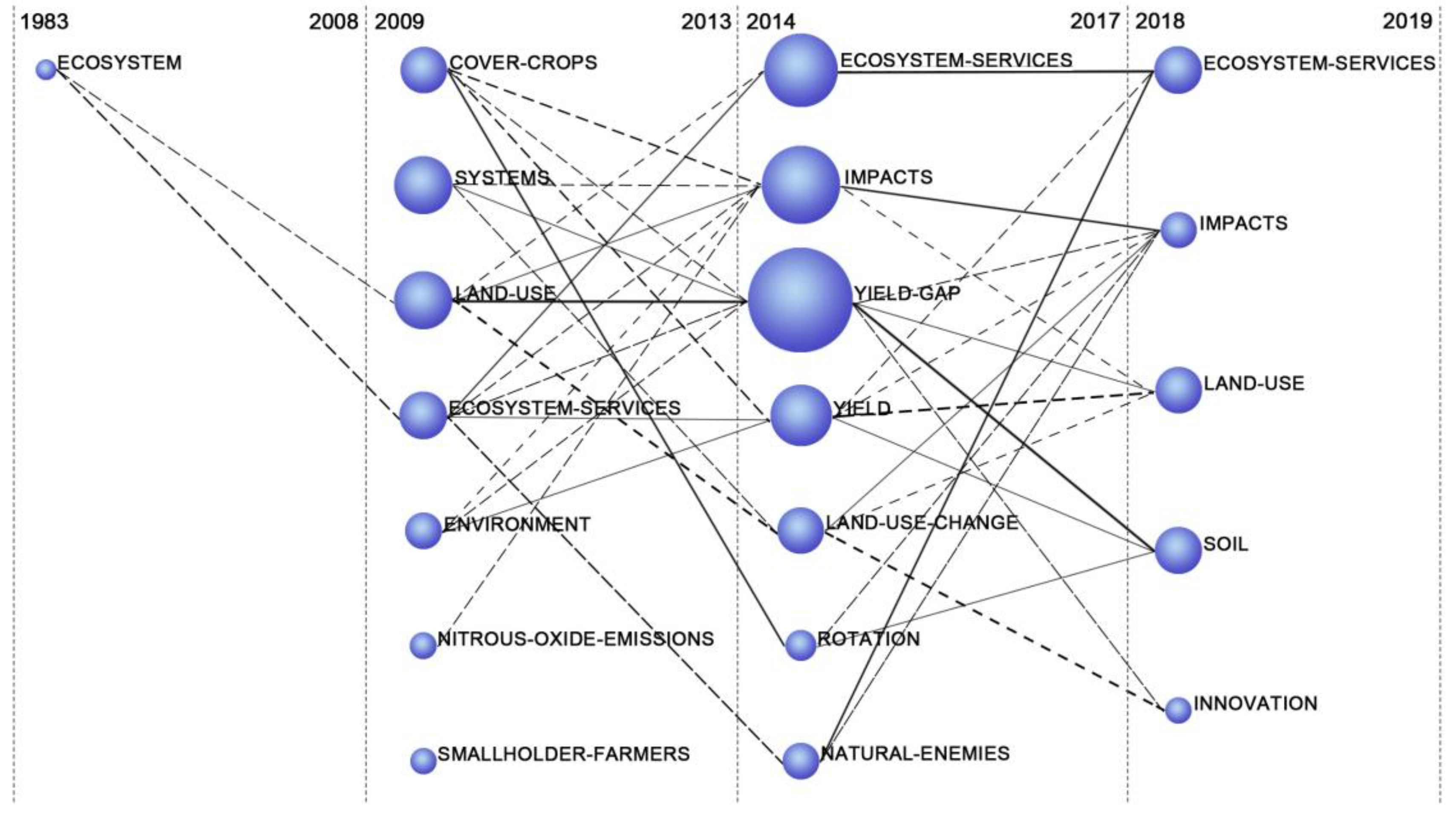
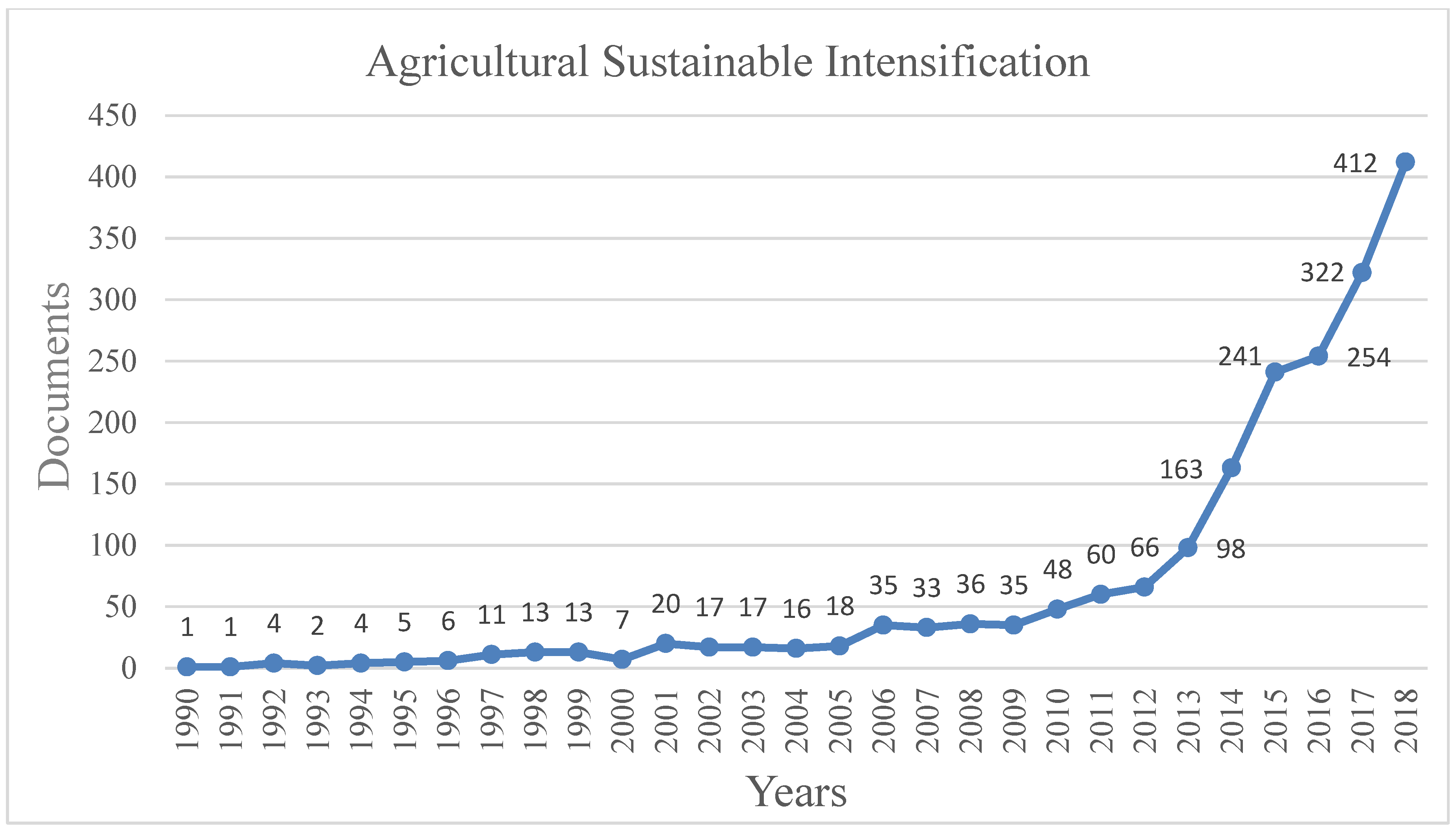
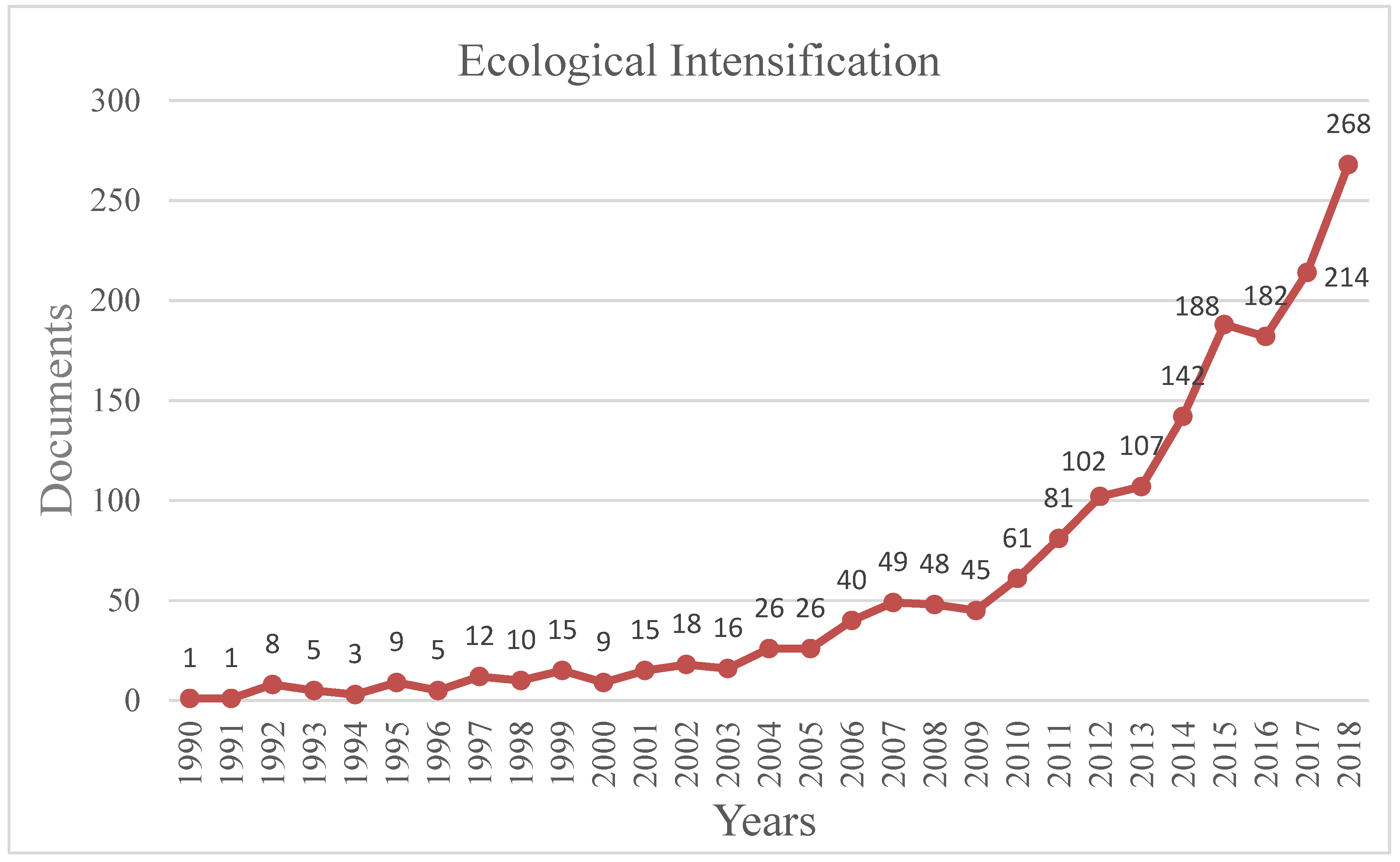
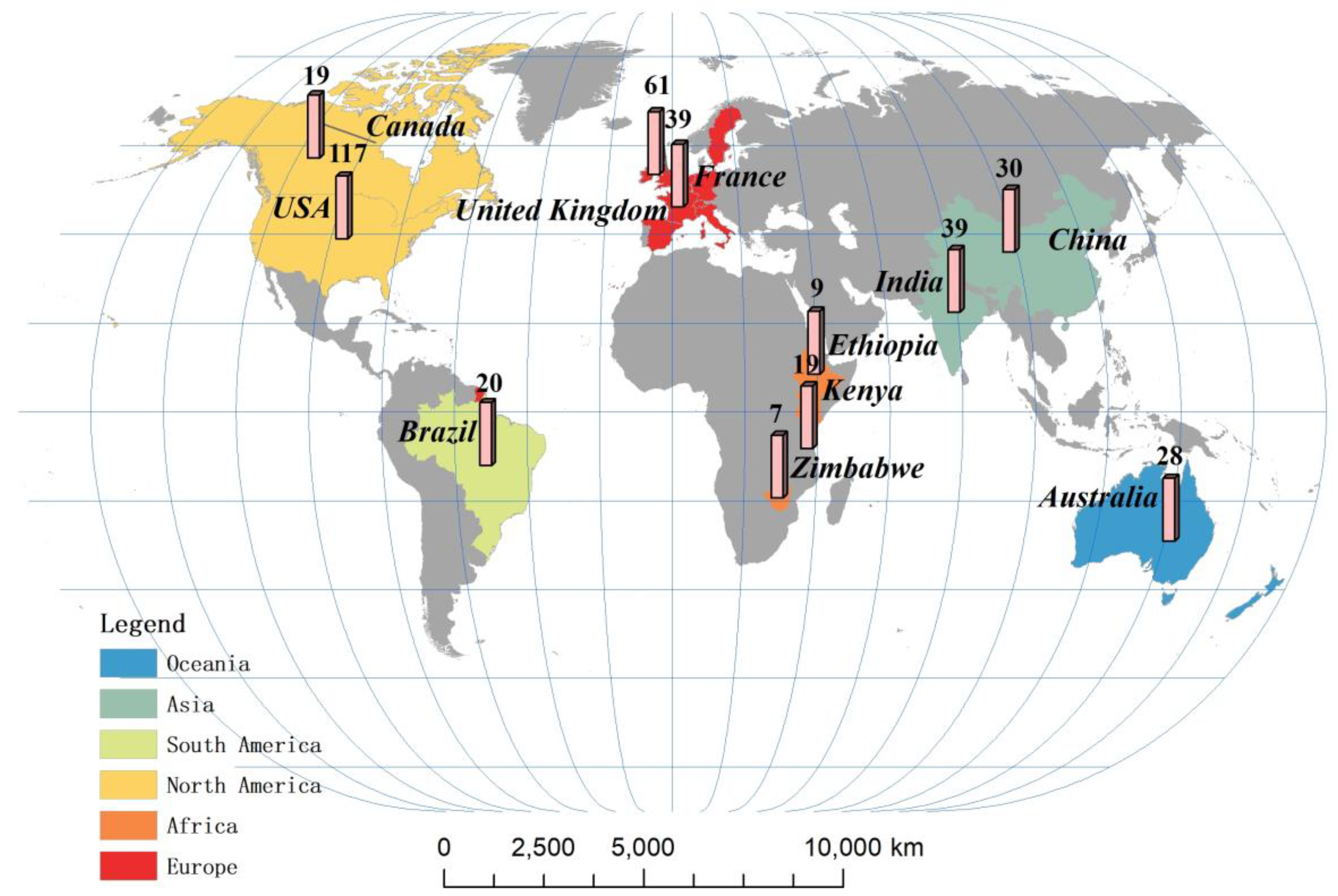
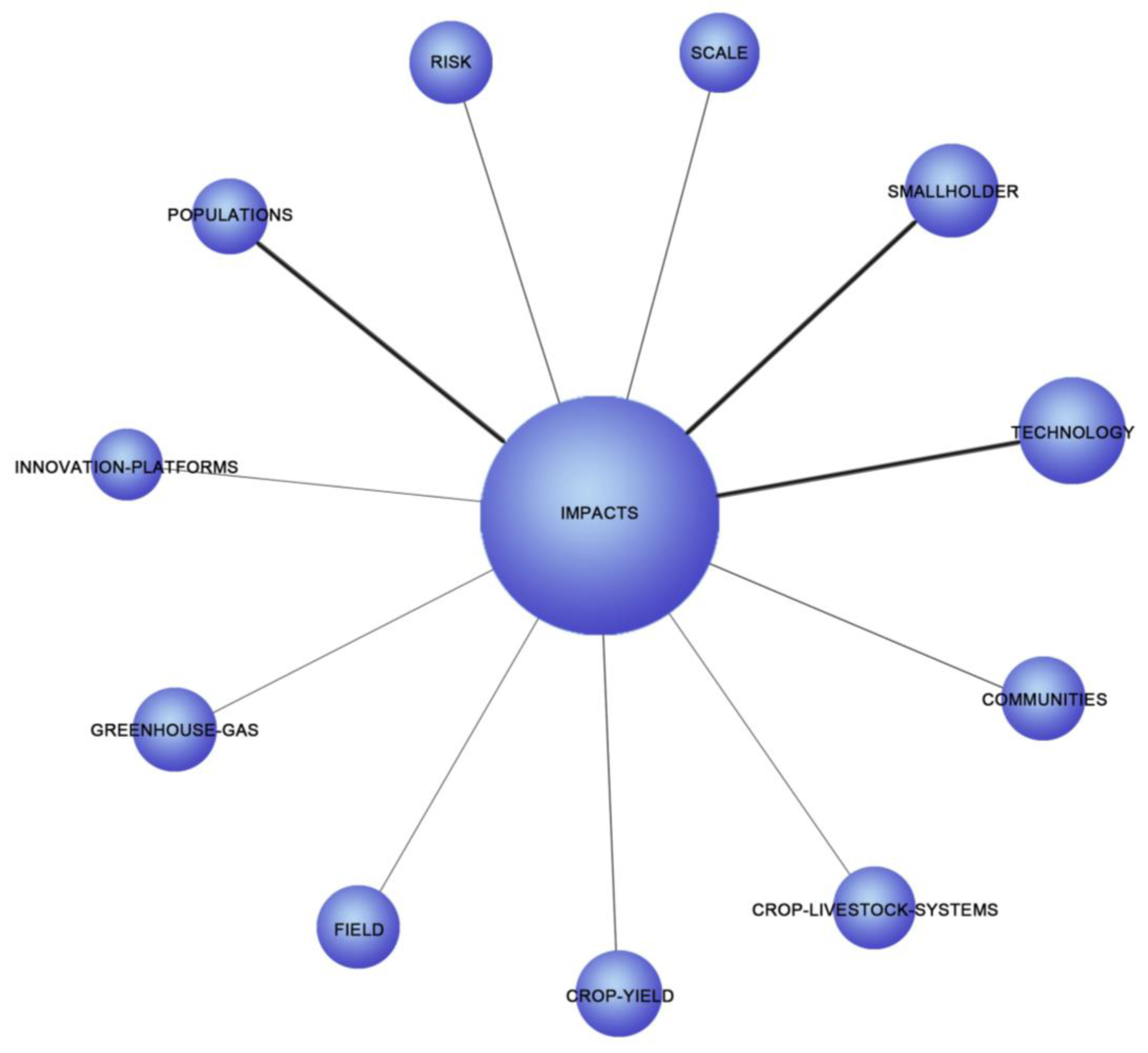
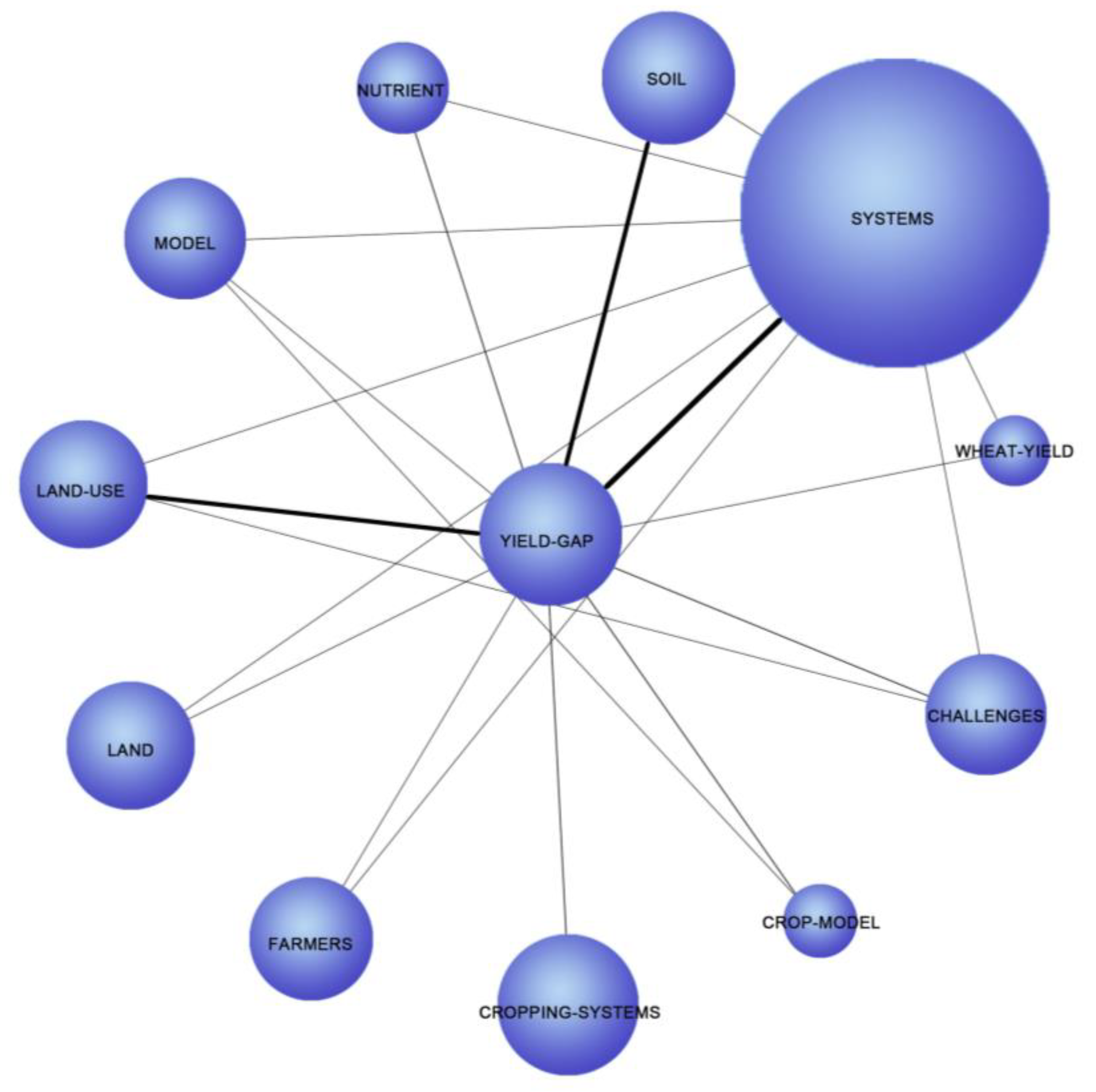
| Agricultural Sustainable intensification | Source | |
|---|---|---|
| Characteristics/Definitions | 1. Significantly increase production while protecting natural resources. | [37] |
| 2. Control inputs and outputs of livestock production systems to increase productivity or production while maintaining system and environmental integrity. | [49] | |
| 3. Improve the return of land and labor, and maintain soil nutrient balance. | [50] | |
| 4. Strengthen the use of natural, social and human assets, and use the best available technologies and inputs to minimize environmental damage. | [51] | |
| 5. Increase production without affecting the environment and not cultivating more land. | [39,57] | |
| Principles | 1. Reduce land use and increase the use of renewable resources such as labor, light and knowledge to increase production. | [56,64] |
| 2. Improve resource use efficiency, optimize the application of external inputs, reduce the negative impact of food production on the environment, and narrow the output gap. | [65,37] | |
| 3. Improve the use of crop varieties and livestock breeds. | [50,51] | |
| 4. Reduce food waste and increase productivity. | [55] | |
| Practices | 1. Conservation tillage, crop rotation, and using biofouling and residual plastic film to cover soil. | [10] |
| 2. Use beans, cover crops and harvest crops in crop rotation. | [12] | |
| 3. Integrated pest management. | [37] | |
| 4. Soil and water conservation, and effective management of soil health. | [1,10] | |
| 5. Plant genetic resources protection, and improved varieties. | [1] | |
| 6. Water management, fertigation, inadequate irrigation, supplementary irrigation. | [1] |
| Ecological Intensification | Source | |
|---|---|---|
| Characteristics/Definitions | 1. Strengthen the production system to increase grain production while minimizing the negative impacts on the environment. | [44] |
| 2. Improve the efficiency of investment and resource use. | [30,45] | |
| 3. A system that utilizes ecological processes and services. | [45,66] | |
| 4. Increase food production while reducing external inputs and minimizing negative impacts on the environment, and using ecological processes and ecosystem services from plot to landscape scale. | [10] | |
| 5. Reduce production gaps while reducing external inputs; rely on local agricultural system knowledge. | [67] |
| Study Area | Scale | Influencing Factor | Source |
|---|---|---|---|
| Brazilian Amazon | farm | market access, product prices, ranch facilities, credit access, lack of marketing options. | [34] |
| Central and southern Malawi | farmer | low soil fertility, population density, market access, imperfect infrastructure, farmers’ preferences. | [28] |
| Central Malawi | farm | gender preferences, weather conditions, population density, crop prices, farm size. | [72] |
| Central Andes | region | climate change, planting disturbances, over grazing, mining activities. | [89] |
| Eastern and southern Africa | plot | market access, agricultural extension services, information scarcity, technology adoption. | [26] |
| Eastern and western Kenya | farmer | gender differences, technology gaps, market access, land quality, credit opportunities, extension services. | [27] |
| East Africa (Ethiopia, Kenya and Uganda) | country | lack of investment incentives, insufficient agricultural extension systems imperfect infrastructure. | [76] |
| Eastern Uganda | farmer | population pressure, market information, price volatility, climate change, low yield, farmer livelihood. | [88] |
| Eastern Kenya | farm | population density, land quality, access to information, farmers’ behavior, climatic conditions. | [90] |
| Germany | plot | population pressure, food demand, soil organic matter, slope, soil depth. | [58] |
| Sub-Saharan Africa | farmer | soil fertility, population pressure, production gap, livelihood strategy, market access. | [29] |
| Southern Kenya | village | population density, crop price fluctuations, rainfall. | [91] |
| Tropical reunion | farm | population pressure, food demand growth, environmental stress, farm type. | [92] |
© 2019 by the authors. Licensee MDPI, Basel, Switzerland. This article is an open access article distributed under the terms and conditions of the Creative Commons Attribution (CC BY) license (http://creativecommons.org/licenses/by/4.0/).
Share and Cite
Xie, H.; Huang, Y.; Chen, Q.; Zhang, Y.; Wu, Q. Prospects for Agricultural Sustainable Intensification: A Review of Research. Land 2019, 8, 157. https://doi.org/10.3390/land8110157
Xie H, Huang Y, Chen Q, Zhang Y, Wu Q. Prospects for Agricultural Sustainable Intensification: A Review of Research. Land. 2019; 8(11):157. https://doi.org/10.3390/land8110157
Chicago/Turabian StyleXie, Hualin, Yingqian Huang, Qianru Chen, Yanwei Zhang, and Qing Wu. 2019. "Prospects for Agricultural Sustainable Intensification: A Review of Research" Land 8, no. 11: 157. https://doi.org/10.3390/land8110157
APA StyleXie, H., Huang, Y., Chen, Q., Zhang, Y., & Wu, Q. (2019). Prospects for Agricultural Sustainable Intensification: A Review of Research. Land, 8(11), 157. https://doi.org/10.3390/land8110157







